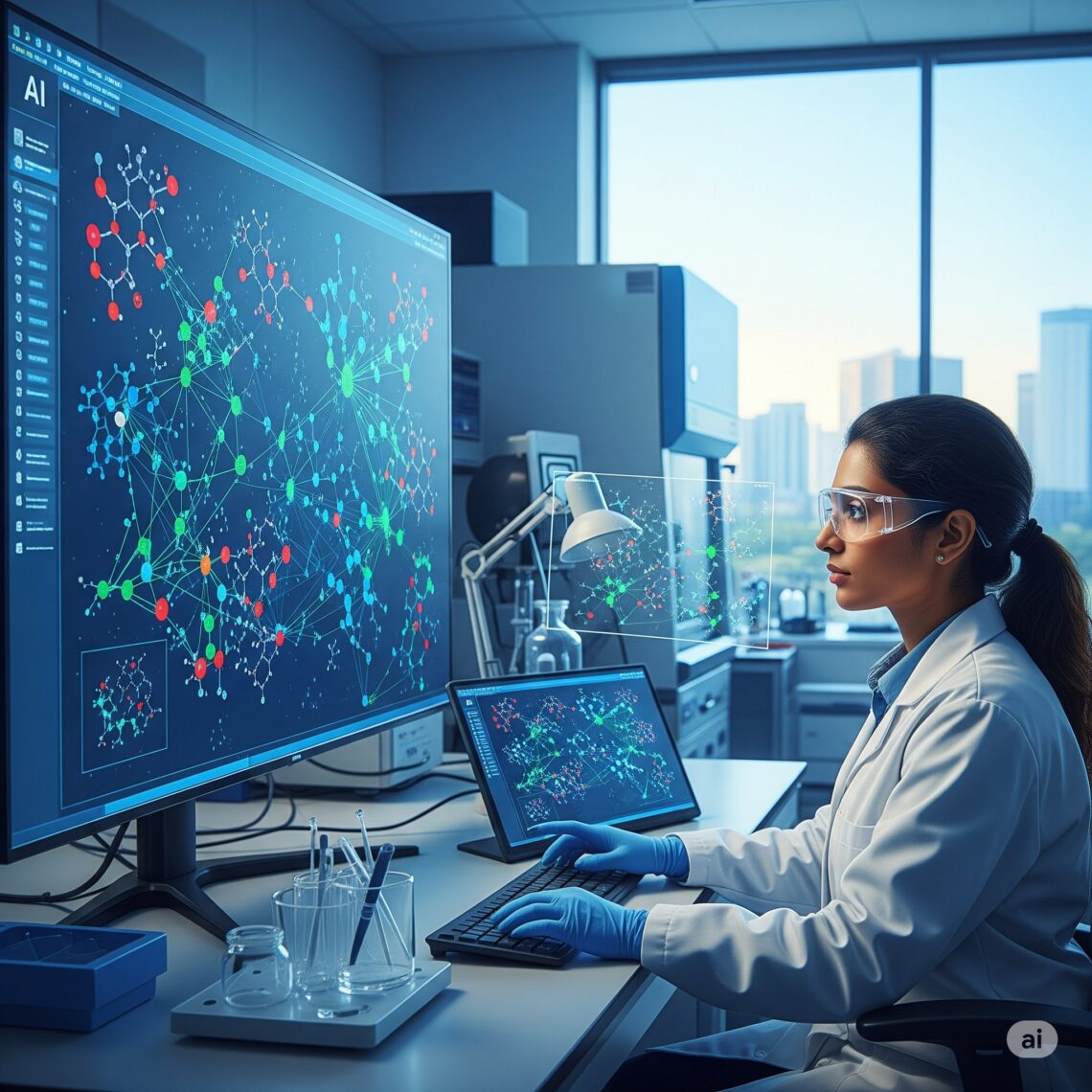The journey of bringing a new drug to market is notoriously arduous, a marathon of scientific endeavor that often stretches over a decade and consumes billions of dollars. From initial target identification to rigorous clinical trials and eventual regulatory approval, the traditional drug discovery pipeline is characterized by high costs, lengthy timelines, and a dauntingly low success rate. However, a revolutionary force is now accelerating this pipeline: Artificial Intelligence (AI). By leveraging vast amounts of data and sophisticated algorithms, AI is rapidly transforming drug discovery, enabling scientists to identify new drug candidates, optimize molecules, predict trial outcomes, and ultimately, bring life-saving therapies to patients faster and more efficiently.
The Traditional Drug Discovery Pipeline
To fully appreciate AI’s impact, it’s essential to understand the conventional drug development process, which has remained largely unchanged for decades:
- Target Identification: Scientists pinpoint specific molecules (like proteins or genes) in the body that play a role in a disease process and could potentially be targeted by a drug.
- Drug Design/Lead Discovery: Researchers then search for or design chemical compounds (leads) that can interact with the identified target. This often involves high-throughput screening of massive compound libraries.
- Preclinical Trials: Promising lead compounds undergo extensive lab (in vitro) and animal (in vivo) testing to assess their efficacy, dosage, and initial safety.
- Clinical Trials: If preclinical results are promising, the drug moves to human testing, typically in three phases:
- Phase I: Small group (20-100 healthy volunteers) to assess safety and dosage.
- Phase II: Larger group (100s of patients) to evaluate efficacy and further safety.
- Phase III: Large group (1,000s of patients) to confirm efficacy, monitor side effects, and compare with existing treatments.
- Regulatory Approval: Data from all trials is submitted to regulatory bodies (like FDA in the US, EMA in Europe) for approval.
- Post-Market Surveillance: Ongoing monitoring of the drug’s safety once it’s on the market.
This entire process typically takes 10–15 years from concept to market, with an average cost estimated to be well over $2.5 billion per successful drug, largely due to the high failure rate at each stage.
How AI is Transforming Each Stage
AI is not just optimizing one part of this pipeline; it’s revolutionizing every single stage, from the earliest research to post-market monitoring:
a. Target Identification and Validation
AI’s ability to process and analyze vast, complex datasets is invaluable here. AI algorithms can:
- Mine biomedical literature: Rapidly sift through millions of research papers to uncover novel disease pathways and potential therapeutic targets.
- Analyze genomic data: Identify genetic variations linked to diseases and pinpoint proteins that play a critical role in disease development.
- Process protein interaction databases: Map out complex networks of protein interactions to find new vulnerabilities that can be targeted by drugs.
- Tools: Companies like BenevolentAI leverage AI to identify novel drug targets by integrating genomic, clinical, and scientific literature data. While IBM Watson for Drug Discovery was discontinued, its early efforts highlighted the potential of AI in this foundational stage. Atomwise also uses AI for rapid target identification.
b. Drug Candidate Screening
Traditionally, screening involves physically testing millions of compounds. AI dramatically accelerates this:
- Rapid Virtual Screening: AI models can rapidly “scan” through billions of virtual compounds (chemical structures) in a fraction of the time it would take in a wet lab. They predict how likely a compound is to bind to a specific drug target.
- Deep Learning and Structure-based Models: These advanced AI techniques predict molecular interactions based on the 3D structures of both the drug candidate and the target protein, vastly improving the accuracy of virtual hits.
c. Drug Design & Optimization
This is where generative AI truly shines, moving beyond just screening existing compounds:
- De Novo Drug Design: AI can design novel molecules from scratch, generating new chemical structures that have the desired properties to interact with a specific target. This is analogous to how generative AI creates images or text, but applied to chemical structures.
- Generative AI for Molecules: Using techniques similar to those powering large language models (like variational autoencoders or generative adversarial networks), AI can learn the rules of chemical synthesis and propose entirely new compounds with optimal binding affinities, solubility, and other key pharmacological properties.
- Tools: Insilico Medicine is a leader in using generative AI for de novo drug design. DeepMind’s AlphaFold (and AlphaFold 2) has fundamentally solved the protein folding problem, accurately predicting the 3D structure of proteins from their amino acid sequence. This is revolutionary because a protein’s 3D structure dictates its function, providing critical insights for designing drugs that precisely interact with them. NVIDIA BioNeMo is another powerful platform that supports AI for molecular dynamics and protein folding.
d. Predicting Drug Toxicity & Side Effects
Identifying potential toxicity early is crucial to prevent costly failures in later stages:
- In Silico Simulations: AI can simulate how drug candidates interact with biological systems at a molecular level, predicting potential toxicity, metabolism pathways, and adverse effects long before any wet lab or animal testing is required.
- Reduced Animal Testing and Trial Failures: By filtering out toxic or ineffective compounds earlier, AI reduces the ethical concerns and costs associated with extensive animal testing and minimizes the risk of expensive failures in human clinical trials.
e. Clinical Trial Optimization
AI enhances the efficiency and success rates of clinical trials:
- Patient Selection: AI analyzes patient data (EHRs, genomic data) to identify individuals who are most likely to respond to a particular drug, improving trial efficacy and reducing variability.
- Biomarker Identification: AI can find novel biomarkers that indicate disease progression or drug response, helping monitor trial participants more effectively.
- Predicting Trial Outcomes: AI models can analyze historical trial data and patient characteristics to predict the likelihood of success or failure for ongoing or future trials, allowing for adaptive trial designs.
- Example: During the COVID-19 pandemic, AI was crucial for rapidly identifying and repurposing existing drugs for treatment. AI platforms accelerated the analysis of vast datasets to predict which compounds might be effective.
f. Drug Repurposing
This is a fast-track to new treatments using existing knowledge:
- New Uses for Old Drugs: AI excels at analyzing vast biomedical datasets, including drug side effect profiles, gene expression data, and disease pathways, to identify novel therapeutic uses for already approved or shelved drugs.
- Example: BenevolentAI famously identified Baricitinib, an existing anti-inflammatory drug, as a potential treatment for COVID-19 by analyzing its molecular properties and interactions with the virus, which was later used in combination therapy for severe cases.
Real-World Examples
AI’s impact on drug discovery is no longer theoretical, with several companies achieving tangible successes:
- Insilico Medicine: This pioneering company achieved a remarkable feat by using its AI platform to identify a novel drug target, design a new molecule, and move it into Phase I clinical trials for idiopathic pulmonary fibrosis (IPF) in under 2 years—a process that typically takes 5-7 years or more.
- Exscientia: This AI-driven pharmaceutical company successfully designed an AI-designed molecule for obsessive-compulsive disorder (OCD), which entered Phase I clinical trials, demonstrating AI’s ability to create novel compounds for complex neurological conditions.
- AlphaFold by DeepMind: While not directly a drug discovery company, AlphaFold’s breakthrough in solving the protein structure prediction problem (accurately predicting a protein’s 3D shape from its amino acid sequence) has been vital for understanding disease mechanisms and designing drugs that precisely target these structures. Its database is a fundamental resource for drug researchers globally.
Benefits of AI in Drug Discovery
The advantages of integrating AI into drug discovery are profound:
- Time Savings: AI can dramatically slash development timelines, reducing early phase research from years to mere months, potentially cutting the overall time to market from 10+ years to a significantly shorter period.
- Cost Reduction: By identifying and eliminating ineffective or toxic drug candidates early in the pipeline, AI helps pharmaceutical companies save enormous amounts of money, preventing costly failures in late-stage clinical trials.
- Accuracy: AI’s data-driven approach reduces guesswork, leading to more accurate predictions of drug efficacy, safety, and interactions, thereby increasing the probability of success.
- Personalized Medicine: AI’s ability to integrate and analyze patient-specific genomics and other omics data enables the design of highly targeted drugs tailored to individual patients, ushering in an era of true precision medicine.
Challenges and Limitations
Despite its immense potential, AI in drug discovery faces significant hurdles:
- Data Quality and Bias: AI models are only as good as the data they are trained on. Inaccurate, incomplete, or biased datasets can lead to flawed predictions and potentially ineffective or harmful drug candidates.
- Regulatory Acceptance: Regulatory bodies like the FDA are still evolving their frameworks to evaluate and approve drugs developed or optimized with significant AI involvement. Establishing trust and clear guidelines is crucial.
- Interpretability (Black-box Models): Many powerful AI models, particularly deep learning networks, operate as “black boxes,” meaning their decision-making processes are opaque. For critical medical decisions, understanding why an AI made a certain prediction is crucial, posing a challenge to trust and validation.
- Ethical Concerns: Issues arise regarding the ownership of AI-generated drugs (intellectual property), the ethical use of patient data for training AI, and accountability if AI-designed drugs cause unforeseen harm.
The Future of AI in Pharma
The trajectory of AI in pharmaceuticals points towards an increasingly integrated and sophisticated future:
- AI-integrated end-to-end pipelines: Expect to see seamless integration of AI tools across the entire drug discovery and development pipeline, forming highly automated and intelligent systems.
- Quantum Computing + AI: The nascent field of quantum computing holds immense promise for molecular simulations. Its combination with AI could enable unparalleled accuracy in predicting molecular interactions and designing highly complex drugs.
- Greater Collaboration: The pharmaceutical industry will witness deeper and more frequent collaborations between established biotech firms and agile AI startups, pooling resources and expertise.
- Regulatory Frameworks Adapting: Regulatory bodies worldwide will continue to develop and refine their guidelines specifically for AI-guided drug development processes, ensuring safety and efficacy while fostering innovation.
Conclusion
Artificial Intelligence is not merely a supplementary tool; it is a fundamental force transforming drug discovery at its core. While AI is not replacing the ingenuity and critical thinking of human scientists, it is profoundly empowering them, allowing them to navigate the complexities of biology and chemistry with unprecedented speed and precision. Thanks to AI, the journey of drug discovery is becoming faster, significantly cheaper, and remarkably more precise, promising to unlock new therapeutic avenues that were previously unimaginable. This transformation is still evolving, but its potential impact on global health—leading to the development of life-saving medicines at a faster pace and lower cost—is nothing short of profound.





